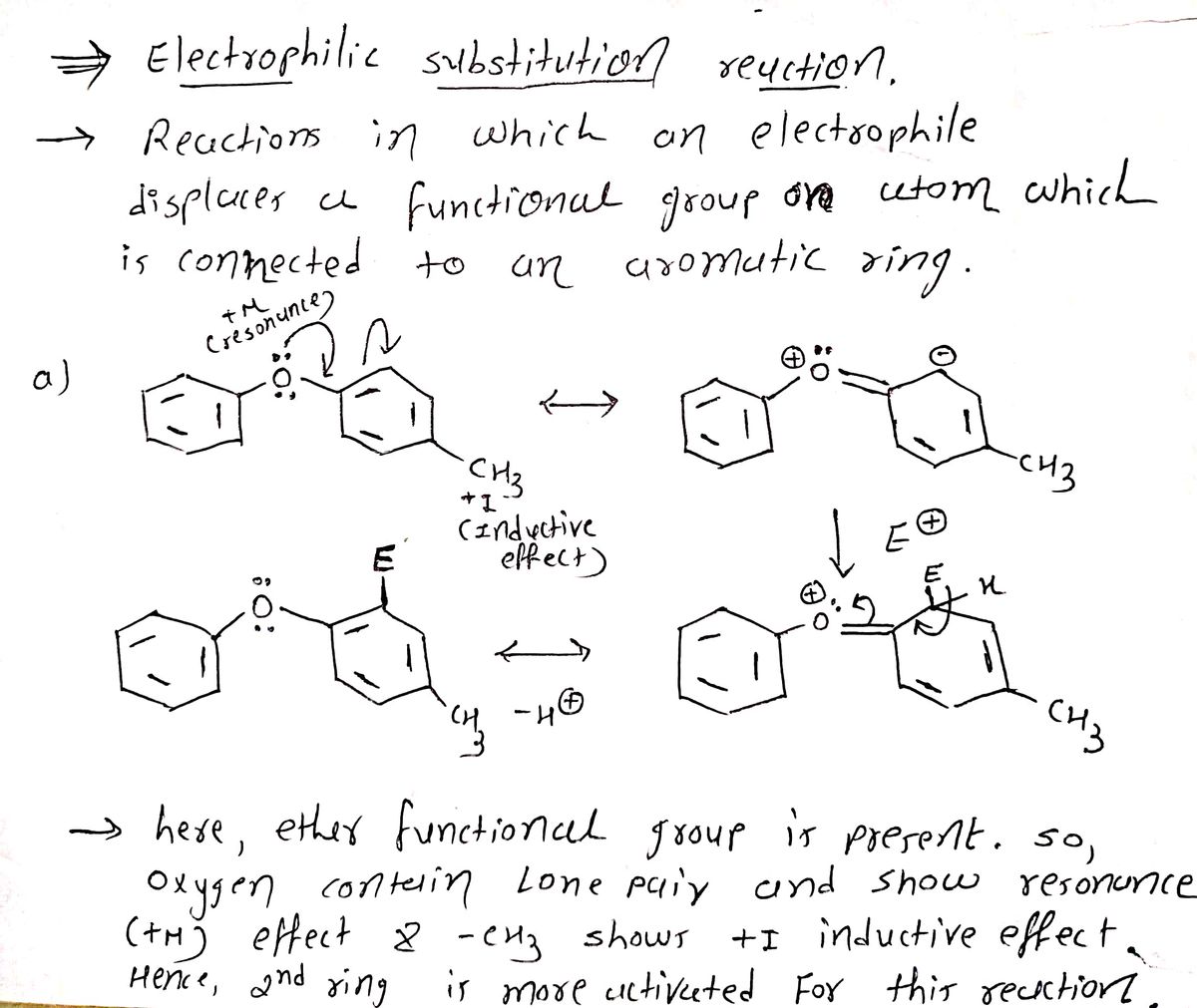9. At what position, and on what ring, would you expect the following substances to undergo electrophilic substitution? H "oa "bra "oko" a) CH3 b) Br c)
9. At what position, and on what ring, would you expect the following substances to undergo electrophilic substitution? H "oa "bra "oko" a) CH3 b) Br c)
Chemistry
10th Edition
ISBN:9781305957404
Author:Steven S. Zumdahl, Susan A. Zumdahl, Donald J. DeCoste
Publisher:Steven S. Zumdahl, Susan A. Zumdahl, Donald J. DeCoste
Chapter1: Chemical Foundations
Section: Chapter Questions
Problem 1RQ: Define and explain the differences between the following terms. a. law and theory b. theory and...
Related questions
Question

Transcribed Image Text:**Question 9:**
At what position, and on what ring, would you expect the following substances to undergo electrophilic substitution?
**a)** This compound has a structure with two benzene rings connected by an ether linkage (an oxygen atom), with one of the rings having a methyl group (CH₃) attached to it.
**b)** This compound consists of two benzene rings connected by an amine linkage (a nitrogen atom with hydrogen). A bromine atom (Br) is attached to one of the benzene rings.
**c)** This compound features two benzene rings connected by a ketone linkage (a carbonyl group), with a chlorine atom (Cl) attached to one of the benzene rings.
*Graphical Explanation:*
- **a)** The ether linkage (O) is connecting the two benzene rings, and a methyl group is directly attached to one of the rings potentially activating it for substitution.
- **b)** The amine linkage (NH) connects two benzene rings, while a bromine atom is attached to one of the rings, affecting its reactivity in electrophilic substitution.
- **c)** The presence of the carbonyl group (C=O) serves as a linkage between two benzene rings, with a chlorine atom connected to one of the rings, influencing its chemical behavior.
Consider how the substituents and linkages influence electron density on each benzene ring for electrophilic substitution predictions.
Expert Solution
Step 1

Step by step
Solved in 2 steps with 2 images

Knowledge Booster
Learn more about
Need a deep-dive on the concept behind this application? Look no further. Learn more about this topic, chemistry and related others by exploring similar questions and additional content below.Similar questions
Recommended textbooks for you

Chemistry
Chemistry
ISBN:
9781305957404
Author:
Steven S. Zumdahl, Susan A. Zumdahl, Donald J. DeCoste
Publisher:
Cengage Learning

Chemistry
Chemistry
ISBN:
9781259911156
Author:
Raymond Chang Dr., Jason Overby Professor
Publisher:
McGraw-Hill Education

Principles of Instrumental Analysis
Chemistry
ISBN:
9781305577213
Author:
Douglas A. Skoog, F. James Holler, Stanley R. Crouch
Publisher:
Cengage Learning

Chemistry
Chemistry
ISBN:
9781305957404
Author:
Steven S. Zumdahl, Susan A. Zumdahl, Donald J. DeCoste
Publisher:
Cengage Learning

Chemistry
Chemistry
ISBN:
9781259911156
Author:
Raymond Chang Dr., Jason Overby Professor
Publisher:
McGraw-Hill Education

Principles of Instrumental Analysis
Chemistry
ISBN:
9781305577213
Author:
Douglas A. Skoog, F. James Holler, Stanley R. Crouch
Publisher:
Cengage Learning

Organic Chemistry
Chemistry
ISBN:
9780078021558
Author:
Janice Gorzynski Smith Dr.
Publisher:
McGraw-Hill Education

Chemistry: Principles and Reactions
Chemistry
ISBN:
9781305079373
Author:
William L. Masterton, Cecile N. Hurley
Publisher:
Cengage Learning

Elementary Principles of Chemical Processes, Bind…
Chemistry
ISBN:
9781118431221
Author:
Richard M. Felder, Ronald W. Rousseau, Lisa G. Bullard
Publisher:
WILEY